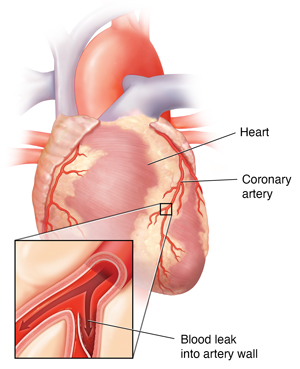Understanding Spontaneous Coronary Artery Dissection (SCAD)
Coronary artery dissection is an emergency condition. It occurs when a tear develops in the wall of one of the arteries that supplies blood to the heart muscle (coronary artery).
Artery walls have three layers. Blood can leak between the layers of the artery wall. This causes a loose, weak flap of tissue. Blood can also clot between the layers of the artery. This can narrow the artery and block blood flow to the heart muscle. Blocked blood flow can cause a heart attack and possibly sudden death.

Coronary artery dissection is a rare cause of heart attacks. But it can occur in people with no risk factors for cardiovascular disease. This condition is more common in younger people and in people assigned female at birth. The average age of SCAD is 40 to 50. But it can occur at any age. SCAD can also happen in men.
Causes of SCAD
The cause of SCAD is unclear. Experts also don’t know how to prevent it. But you are at higher risk for SCAD if you:
-
Are female
-
Are pregnant or recently gave birth
-
Have fibromuscular dysplasia. This causes abnormal cells to grow in artery walls.
-
Have an inflammatory blood vessel disease, such as lupus
-
Have a connective tissue disorder, such as Marfan syndrome or vascular Ehlers-Danlos syndrome
-
Use recreational drugs, such as cocaine
Hormones may also play a role because SCAD is more common in women during menopause. In men, it can occur after extreme exertion.
Symptoms of SCAD
A heart attack is often the first and only sign of SCAD. Symptoms of heart attack include:
-
Chest discomfort. Most heart attacks involve discomfort in the center of the chest that lasts more than a few minutes. Or discomfort that goes away and comes back. It can feel like pressure, squeezing, burning, fullness, tightness, or pain. It's often described as something heavy sitting on your chest.
-
Discomfort in other areas of the upper body. Symptoms can include pain or discomfort in one or both arms, the back, neck, jaw, or stomach.
-
Shortness of breath. This can be without chest discomfort.
-
Other signs. These may include breaking out in a cold sweat, feeling nauseated, or feeling lightheaded.
Note for women. Like men, women most commonly have chest pain or discomfort as a heart attack symptom. But women are somewhat more likely than men to have some of the less common symptoms. These include shortness of breath, heartburn, nausea and vomiting, back pain, arm pain, or jaw pain.
Note for older people. Older people may also have different symptoms. The symptoms include fainting (syncope), weakness, or confusion (delirium). These symptoms should be looked at right away. Ignoring them can lead to critical illness or death.
Diagnosing SCAD
Your healthcare provider may suspect SCAD based on certain factors, such as young age, female gender, and few or no traditional cardiovascular risk factors. You may have coronary angiography and other imaging tests to give more detail about the walls of the artery.
Treatment for SCAD
Treatment depends on your situation and factors, such as your symptoms, severity of the disease, and location and size of the tear in the wall of the artery. In many cases, a dissected coronary artery will heal on its own.
In some cases, you may need treatment to restore blood flow. This may include:
-
Percutaneous coronary intervention or angioplasty, possibly with stent placement. This procedure is done using a balloon-tipped catheter that is thread through an artery to the blocked area of the heart.
-
Coronary artery bypass surgery). This is open heart surgery.
-
Medicine to treat symptoms, such as chest pain
Follow-up care
You will need to have regular follow-up appointments with a healthcare provider who is familiar with SCAD. Your provider may advise yearly imaging tests to keep track of your condition and to look for any changes. SCAD can reoccur.
It’s also important to be assessed and treated for conditions that may be linked to SCAD.
Cardiac rehab is advised if you have SCAD. This is a supervised program designed and customized for you by your healthcare team. It will help you recover from your heart problem. A cardiac rehab program can include:
-
Assessment of your health
-
Management of risk factors or conditions
-
Monitored exercise
-
Education on diet and medicines
-
Quitting smoking
-
Weight loss
-
Counseling and emotional support
Call 911
Call 911 right away if you have:
When to call your healthcare provider
Call your healthcare provider right away if you have:
-
Lightheadedness, dizziness, or fainting
-
Feeling of irregular heartbeat or fast pulse